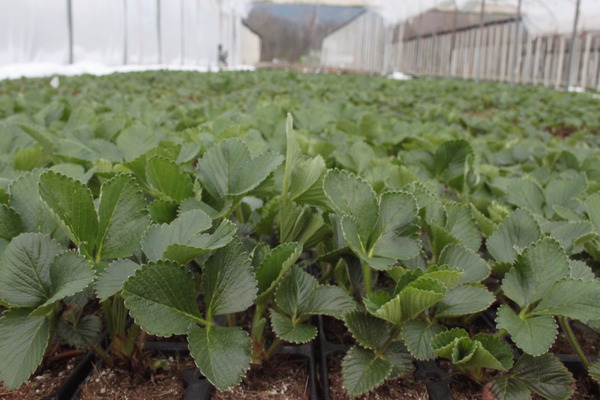 When we offer an entire new assortment of strawberry plants, actually of strawberry young plants, we are pursuing two goals. First, we want to offer a strawberry plant assortment that has been bred specifically for the requirements of the home garden, and not simply use bad and quite industrial varieties from professional fruit production that have been bred for producing high input crops wanted by strawberry producers. Secondly, thanks to our very easy-to-use young plant qualities, we would like to give more plant production companies – from tree nurseries and garden nurseries to pot plant companies – the opportunity to produce their own strawberry plants for the garden market.
When we offer an entire new assortment of strawberry plants, actually of strawberry young plants, we are pursuing two goals. First, we want to offer a strawberry plant assortment that has been bred specifically for the requirements of the home garden, and not simply use bad and quite industrial varieties from professional fruit production that have been bred for producing high input crops wanted by strawberry producers. Secondly, thanks to our very easy-to-use young plant qualities, we would like to give more plant production companies – from tree nurseries and garden nurseries to pot plant companies – the opportunity to produce their own strawberry plants for the garden market.
However, there are a few points to consider so that the plant producer can also provide the right strawberry plant quality at the right time of sale.
Strawberry plants for the spring season
Meanwhile, it can also be observed that the main sales period for strawberry plants is shifting from the classic strawberry season (in late summer) to spring. With such a serious shift, the production times of strawberry plants must of course also be adjusted.
Strawberry plants: the production of packs (with 6/10/12-cells)
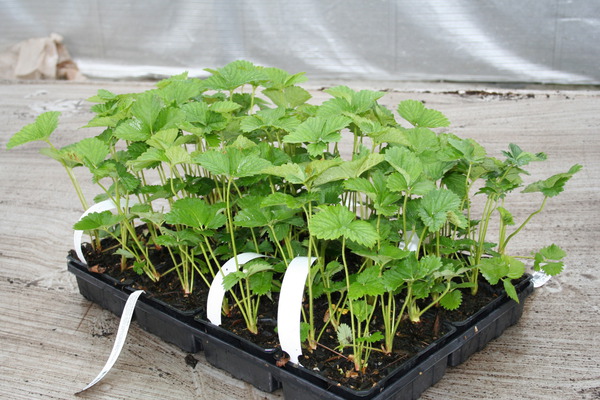
Picture: strawberry plants in a 6-Pack
Despite the trend towards smaller gardens and the associated demand for fewer individual plants, but generally stronger plants, the larger packaging units, the so-called 'packs', are still in demand. In contrast to the larger single pots, these rather smaller plants are mainly used for larger plantings, which are mainly for self-sufficiency.
For the production of these multi-packs, our in vitro plugs should ideally be used. In late summer (at the latest in mid-August) these small young plants can be planted directly into the packs filled with a substrate that is as permeable as possible beforehand and cultivated outdoors on a container area until the end of the growing season.
During this time, the very vigorous in vitro plugs root completely through the container and due to the natural short day, only a few, if any, runners are formed and the flowers for the yield in the following year are created. Thus the end consumer has a reliable yield in the same year when the plants have been planted in the spring. This is, of course, especially important in the case of the June-bearing varieties such as Parfum Schweizerherz or Frutium Bonneure, which only flower during the sales season due to the short day cultivation. But even with everbearing varieties such as Parfum® Eternal Love or Double Pleasures®, the flowering behaviour improves due to the pre-cultivation measures and the winter coldness.
At the beginning of the winter, however, these plants should be covered with a heavy winter protection fleece. From the middle to end of January, the finished packs can be cleaned in advance. However, it is important to ensure that the freshly cleaned packs are placed in a protected location wherever possible. Due to the missing leaves, it is possible that crop losses may occur later when there is heavy frost.
Strawberry plants: the production of single pots (9 - 12 cm)
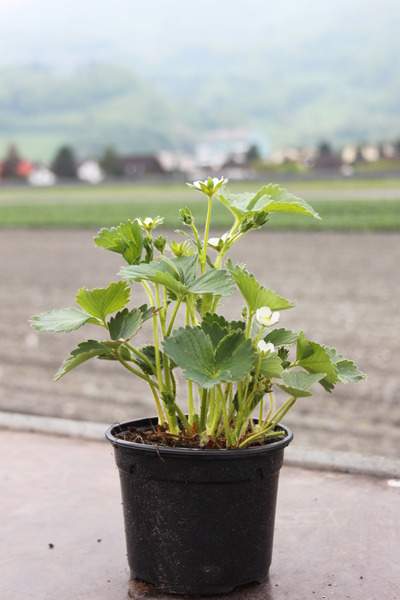
Picture: strawberry in a 12 cm pot
In addition to multi-packs, however, individual pots are also becoming increasingly important. This can be explained by the change in the gardening culture towards smaller gardens and the greater use of balconies and terraces. The end consumer increasingly wants a finished product and wants to buy the strawberry plant almost ready, wide and bushy growing, preferably with flowers.
There are mainly two different ways to offer flowering strawberries planted in individual pots in the spring.
Firstly, this works analogously to the cultivation of multi-packs. In the not too late summer, but already in the noticeable short day, our in vitro plugs are planted directly into the final pot. In order for the plants to develop well, the strawberry plants should not be produced later than the end of July/beginning of August.
The pots can then, immediately after potting, be placed directly outdoors on a container area for root penetration and good flowering. For sales in the spring, these plants must then be thoroughly cleaned. This can be done as early as mid-January. However, in order to avoid any plant losses, the strawberry plants should not be placed directly in the open after cleaning.
Depending on whether a fertilised substrate has been used for potting or not, additional fertilisation will be necessary before the sale. It has been shown that the strawberry varieties with a long shelf life require increased iron intake in the spring.
On the other hand there is the possibility to produce 9 to 12 cm pots in a short cultivation period in the spring for the spring. At this time, however, you have to use a strawberry plant from our standard tray, which has already been overwintered here and has received enough cold. These have already formed flowering plants in the previous year and will therefore certainly bloom. Potting should ideally take place in a protected and, if possible, temperate location. This is the only way to fully exploit the advantages of a short crop. The exact potting time depends on the desired sales period. From this count back 6 - 8 weeks in order to obtain the potting time. Ultimately, the exact cultivation time depends on the pot size and the targeted sales period.
Container plants

Picture: strawberry Double Pleasure® Standing Pink Wonder® in a 5 liter container growing from 3 young plants, completely covered
Strawberry plants in containers (>2 L) are usually only a niche product, but are regularly offered on the market. The production of such strawberry plants is largely identical to the production of strawberry plants in individual pots.
Again, our in vitro plugs can be used as young plants. Potting takes place in the second half of the summer, but not later than the middle or end of July. However, in this case it should be noted that one plant alone is not sufficient to completely fill a container. For a high-quality end product, at least two young plants should be potted in a container. From a size of 4 L, it is advantageous to pot up to three young plants per container. This is the only way to ensure that the pot is filled completely.
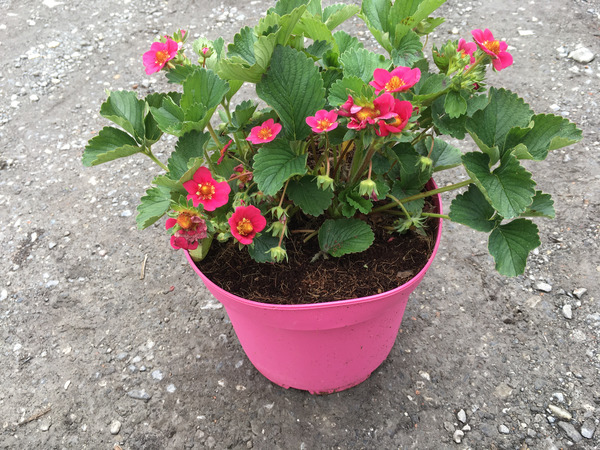
Picture: strawberry Double Pleasure® Standing Pink Wonder® in a 5 liter container growing from 2 young plants, less covered than with 3 young plants
The freshly potted strawberry plants in the container can be placed directly outdoors as usual.
Furthermore, the production of strawberry plants in containers can also be carried out using young plants from our standard tray. Ideally, potting for such production should take place in early spring so that the strawberry plants have sufficient time to root completely through the container. Here, too, it is advisable to pot several young plants in a container in order to obtain a completely filled pot and thus also a high-quality end product.
For this type of production, a protected and temperate location is essential. A cultivation time of 6 - 8 weeks should also be estimated here. Again this all depends on the pot size, the potting time and the climatic conditions in the greenhouse/film tunnel, etc. This results in a potting time of about mid-April for a planned sales period at the end of June.
Production of packs and single pots from overwintered/frigo plugs
A new launch for spring 2020 will be an overwintered or frigo plug. This is an in vitro plug which has been cultivated in autumn and then frozen without leaves. This strawberry young plant is very robust and can be used for a production in cold plastic tunnels or outdoors at a very early date. On the one hand, this has the advantage that the plants remain much more compact, as they do not grow out of control, and on the other hand, plants cultivated in this way have a much longer sales period. However, with this variant a production period of about two weeks longer should be planned. Another feature is that the time-consuming cleaning of the plants before the sale is not necessary with this production method.
The classic strawberry season (late summer/autumn)
The classic season for the sale and planting of strawberry plants is traditionally the second half of the summer, starting in August or mid-July. Of course, the holiday periods in individual regions must be observed in practice. This results from the biology of the strawberry plants. Once the harvest is complete, the strawberry plants start to form runners. These form roots when they come in contact with the soil and they develop into independent strawberry plants that have been dug up and sold in the past. At the same time, in the natural short day, the flowers are formed for the yield in the following year. This is the biological reason for the classical strawberry season. Strawberry plants, which are planted in the garden in late summer, still have enough time to establish themselves at the new location and at the same time, the flowers for the coming yield are created.
Of course there is not the same consumer demand in this sales period, but it is always surprising how well plant customers and hobby gardeners react to fresh, growing plants in the summer, when they are offered: in the garden, flower beds become available that can be immediately planted with new strawberry plants; the strawberry season has just come to an end and the aim is to ensure that the wonderful fruits can also be enjoyed in sufficient quantities next year.
Usually multi-packs are offered in this sales window. Using our in vitro plugs as a young plant, these multi-packs can be produced within a few weeks to a ready to sell strawberry plant. Thus plants that have been grown in the beginning or middle of July can already be sold at the end of August. This results in a production period of about 5 - 6 weeks, depending on the location of the company.
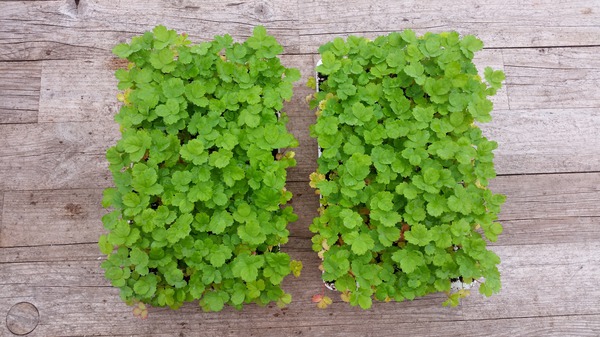
Picture: invitro-plug strawberry youngplants
What the final sale should consider
Especially the final sale should take care to give the hobby gardener the right and most important information about the handling of strawberry plants. This includes not only how to correctly plant the strawberries, but also information and instructions about the cultivation of them. Above all, the final sale should inform the hobby gardener when he/she can expect a yield from the strawberry plants, especially depending on the different sales periods.
In general the following applies:
- Sale of strawberry plants in the spring: can be harvested still in the same year
- Sale of strawberry plants in summer/autumn: harvest in the following year
What the producer should keep in mind
The producer of strawberry plants should also pay attention to a few things. He/she should be aware of what his/her customers expect of strawberry plants or when they should be offered for sale. It is precisely this knowledge that ensures that the end consumer is always offered high-quality strawberry plants that provide a rich yield.
Here is another tip:
Offer and sell strawberries and raspberries together
Some of our customers and our partner company Lubera have had good experiences with offering fresh strawberry young plants and raspberry plants together, especially in the summer sales season, i.e. bringing them together at the point of sale. We are not friends of special offers: but especially the summer time offers good opportunities for meaningful, targeted campaigns...The producer can take advantage of the short production time and precise planning, the seller makes his/her point of sale more attractive with fresh, green plants and the customer can plant next year's yield.
Click here for more information.
Would you like more information, an individual consultation or information about additional ranges?
Click here for the complete 2019 catalogue, which can be downloaded.
If you have specific questions, please do not hesitate to contact our customer service, where you can also spontaneously place an order.
And of course we are always there for you via telephone.
If you want to be regularly informed about news, etc., you can also subscribe to our gardener newsletter here, which we send out about once a month - it's worth it!
